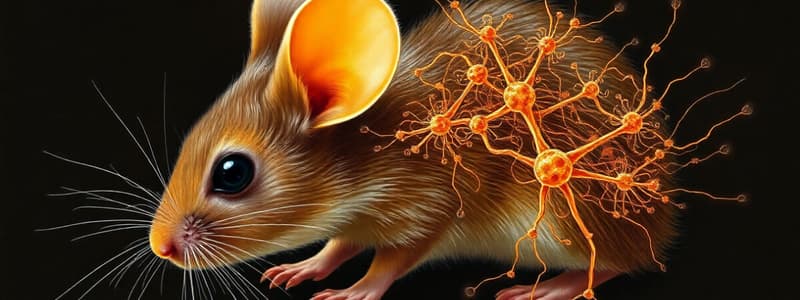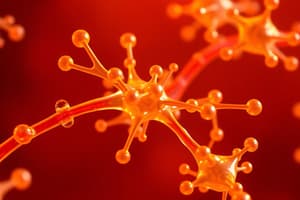Podcast
Questions and Answers
What is the main function of odorant receptors (ORs) in the mouse olfactory system?
What is the main function of odorant receptors (ORs) in the mouse olfactory system?
- To transmit signals to the brain via the olfactory bulb
- To regulate the expression of other genes
- To control the growth and development of olfactory sensory neurons
- To detect and bind to specific odorants (correct)
How many different types of odorant receptors are estimated to be expressed in the mouse olfactory system?
How many different types of odorant receptors are estimated to be expressed in the mouse olfactory system?
- 500
- 10,000
- 1000 (correct)
- 100
What is the unique feature of olfactory sensory neuron (OSN) expression of odorant receptors?
What is the unique feature of olfactory sensory neuron (OSN) expression of odorant receptors?
- OR expression changes over time in each OSN
- Each OSN expresses multiple ORs
- OSNs express only one functional OR gene in a monoallelic manner (correct)
- OR expression is random in each OSN
What is the role of cyclic adenosine monophosphate (cAMP) in olfactory sensory neuron (OSN) axonal projection?
What is the role of cyclic adenosine monophosphate (cAMP) in olfactory sensory neuron (OSN) axonal projection?
What is the difference between the dorsal-ventral (D-V) and anterior-posterior (A-P) axonal projection of olfactory sensory neurons (OSNs)?
What is the difference between the dorsal-ventral (D-V) and anterior-posterior (A-P) axonal projection of olfactory sensory neurons (OSNs)?
What happens to the olfactory map after birth?
What happens to the olfactory map after birth?
What is the role of glomerular structures in the olfactory map?
What is the role of glomerular structures in the olfactory map?
What is the primary focus of the research summarized in this article?
What is the primary focus of the research summarized in this article?
What is the role of the enzyme/selector in the activation of OR genes?
What is the role of the enzyme/selector in the activation of OR genes?
What is the primary mechanism by which ORs regulate axon guidance and sorting?
What is the primary mechanism by which ORs regulate axon guidance and sorting?
Which of the following molecules is involved in the down-regulation of LSD1 after a functional OR gene is activated?
Which of the following molecules is involved in the down-regulation of LSD1 after a functional OR gene is activated?
What is the term used to describe the phenomenon where an olfactory sensory neuron (OSN) expresses only one functional olfactory receptor (OR) gene?
What is the term used to describe the phenomenon where an olfactory sensory neuron (OSN) expresses only one functional olfactory receptor (OR) gene?
What is the proposed function of the H region in regulating OR gene choice?
What is the proposed function of the H region in regulating OR gene choice?
What is the primary function of the unfolded protein response in the context of OR gene expression?
What is the primary function of the unfolded protein response in the context of OR gene expression?
Which of the following is NOT a method used to detect OR molecules in the olfactory system?
Which of the following is NOT a method used to detect OR molecules in the olfactory system?
How does the activity-dependent regulation of glomerular segregation molecules differ from the regulation of A-P targeting molecules?
How does the activity-dependent regulation of glomerular segregation molecules differ from the regulation of A-P targeting molecules?
What is the significance of the enrichment of H3K4me3 in an activated OR-gene region?
What is the significance of the enrichment of H3K4me3 in an activated OR-gene region?
Based on the knockout studies of the H region, what can be concluded about its mode of action?
Based on the knockout studies of the H region, what can be concluded about its mode of action?
What is the primary function of OR-instructed axonal projection in the olfactory system?
What is the primary function of OR-instructed axonal projection in the olfactory system?
Why was it initially thought that OR proteins might function as guidance or adhesion molecules?
Why was it initially thought that OR proteins might function as guidance or adhesion molecules?
What is the significance of the unique expression area of each OR gene in the olfactory epithelium (OE)?
What is the significance of the unique expression area of each OR gene in the olfactory epithelium (OE)?
What is the primary function of cAMP in the context of OR gene expression?
What is the primary function of cAMP in the context of OR gene expression?
Which of these is NOT mentioned as a potential mechanism for regulating OR gene choice?
Which of these is NOT mentioned as a potential mechanism for regulating OR gene choice?
Which of these is NOT a key factor implicated in the singular OR expression in each OSN?
Which of these is NOT a key factor implicated in the singular OR expression in each OSN?
Why were the theories of irreversible DNA changes and gene conversion dismissed as explanations for single OR gene expression?
Why were the theories of irreversible DNA changes and gene conversion dismissed as explanations for single OR gene expression?
What is the 'one neuron-one receptor rule' referring to?
What is the 'one neuron-one receptor rule' referring to?
What is the role of the LCR in the regulation of OR gene expression?
What is the role of the LCR in the regulation of OR gene expression?
According to the content, what is the possible role of Msx1 and Foxg1 in regulating OR gene choice?
According to the content, what is the possible role of Msx1 and Foxg1 in regulating OR gene choice?
How does the expression of a functional OR gene affect the expression of other OR genes in the same neuron?
How does the expression of a functional OR gene affect the expression of other OR genes in the same neuron?
According to the content, what is the primary mechanism that ensures single OR gene expression in a neuron?
According to the content, what is the primary mechanism that ensures single OR gene expression in a neuron?
Which of the following best explains why the olfactory system can detect a vast array of odors despite the 'one neuron-one receptor rule'?
Which of the following best explains why the olfactory system can detect a vast array of odors despite the 'one neuron-one receptor rule'?
What is the key difference between the theories of irreversible DNA changes and gene conversion and the LCR-promoter interaction model?
What is the key difference between the theories of irreversible DNA changes and gene conversion and the LCR-promoter interaction model?
What is the primary function of Golf?
What is the primary function of Golf?
What percentage of amino acid identity do Gs and Golf share?
What percentage of amino acid identity do Gs and Golf share?
Which of the following is NOT a characteristic of the A-P targeting pathway?
Which of the following is NOT a characteristic of the A-P targeting pathway?
How does the level of cAMP influence the A-P targeting process?
How does the level of cAMP influence the A-P targeting process?
What is the primary function of Gs in the context of odorant receptor signaling?
What is the primary function of Gs in the context of odorant receptor signaling?
How does a conditional knockout of Gs affect the expression of A-P targeting molecules?
How does a conditional knockout of Gs affect the expression of A-P targeting molecules?
Which of the following is true regarding the relationship between glomerular segregation and A-P targeting?
Which of the following is true regarding the relationship between glomerular segregation and A-P targeting?
What is the primary role of Kirrel2 and Kirrel3 in the olfactory system?
What is the primary role of Kirrel2 and Kirrel3 in the olfactory system?
What are the two distinct processes involved in the formation of a neural map in the mouse olfactory system?
What are the two distinct processes involved in the formation of a neural map in the mouse olfactory system?
What is the major difference in the source of cAMP signals that leads to the observed distribution of A-P targeting and glomerular segregation molecules?
What is the major difference in the source of cAMP signals that leads to the observed distribution of A-P targeting and glomerular segregation molecules?
During which developmental stage does the refinement of the neural map occur in an activity-dependent manner?
During which developmental stage does the refinement of the neural map occur in an activity-dependent manner?
What is the role of Golf in the olfactory system?
What is the role of Golf in the olfactory system?
How does the equilibrium of conformational transition of GPCRs influence the expression of A-P targeting molecules?
How does the equilibrium of conformational transition of GPCRs influence the expression of A-P targeting molecules?
What is the role of neuronal activity in the expression of glomerular segregation molecules?
What is the role of neuronal activity in the expression of glomerular segregation molecules?
Which of the following describes the major basis for the observed difference in the distribution of A-P targeting (graded) and glomerular segregation (mosaic) molecules?
Which of the following describes the major basis for the observed difference in the distribution of A-P targeting (graded) and glomerular segregation (mosaic) molecules?
What is the main conclusion of the study regarding the regulation of A-P targeting and glomerular segregation?
What is the main conclusion of the study regarding the regulation of A-P targeting and glomerular segregation?
Flashcards
Olfactory Sensory Neurons (OSNs)
Olfactory Sensory Neurons (OSNs)
Neurons that detect odorants using specialized receptors.
Odorant Receptors (ORs)
Odorant Receptors (ORs)
Approximately 1000 different receptors that bind to specific odorant molecules.
Monogenic Expression
Monogenic Expression
Each OSN expresses only one functional OR gene.
Neural Map
Neural Map
Signup and view all the flashcards
Anterior-Posterior (A-P) Projection
Anterior-Posterior (A-P) Projection
Signup and view all the flashcards
Dorsal-Ventral (D-V) Projection
Dorsal-Ventral (D-V) Projection
Signup and view all the flashcards
Glomeruli
Glomeruli
Signup and view all the flashcards
Cyclic Adenosine Monophosphate (cAMP)
Cyclic Adenosine Monophosphate (cAMP)
Signup and view all the flashcards
OR gene expression
OR gene expression
Signup and view all the flashcards
Stochastic choice
Stochastic choice
Signup and view all the flashcards
LCR
LCR
Signup and view all the flashcards
Negative feedback
Negative feedback
Signup and view all the flashcards
One neuron-one receptor rule
One neuron-one receptor rule
Signup and view all the flashcards
Cell lineage
Cell lineage
Signup and view all the flashcards
Transcription factors
Transcription factors
Signup and view all the flashcards
Zone-specific factors
Zone-specific factors
Signup and view all the flashcards
OR-gene locus
OR-gene locus
Signup and view all the flashcards
H3K4me3
H3K4me3
Signup and view all the flashcards
LSD1
LSD1
Signup and view all the flashcards
cAMP
cAMP
Signup and view all the flashcards
Adenylyl cyclase type III (ACIII)
Adenylyl cyclase type III (ACIII)
Signup and view all the flashcards
Mouse olfactory system
Mouse olfactory system
Signup and view all the flashcards
Glomerular secretion molecules
Glomerular secretion molecules
Signup and view all the flashcards
Homophilic interaction
Homophilic interaction
Signup and view all the flashcards
A-P targeting molecules
A-P targeting molecules
Signup and view all the flashcards
Negative feedback signals
Negative feedback signals
Signup and view all the flashcards
OR gene choice
OR gene choice
Signup and view all the flashcards
Cis vs Trans regulation
Cis vs Trans regulation
Signup and view all the flashcards
cAMP as second messenger
cAMP as second messenger
Signup and view all the flashcards
Trans-acting enhancer
Trans-acting enhancer
Signup and view all the flashcards
H region
H region
Signup and view all the flashcards
Gs Protein
Gs Protein
Signup and view all the flashcards
Golf Protein
Golf Protein
Signup and view all the flashcards
A-P Targeting
A-P Targeting
Signup and view all the flashcards
Neuronal Activity
Neuronal Activity
Signup and view all the flashcards
PKA
PKA
Signup and view all the flashcards
CREB
CREB
Signup and view all the flashcards
Glomerular Segregation
Glomerular Segregation
Signup and view all the flashcards
Olfactory Signal Regulation
Olfactory Signal Regulation
Signup and view all the flashcards
Cilia Localization in OSNs
Cilia Localization in OSNs
Signup and view all the flashcards
Axon Termini Role
Axon Termini Role
Signup and view all the flashcards
Temporal and Spatial Insulation
Temporal and Spatial Insulation
Signup and view all the flashcards
Conformational Transition of GPCRs
Conformational Transition of GPCRs
Signup and view all the flashcards
Graded A-P Targeting
Graded A-P Targeting
Signup and view all the flashcards
Mosaic Glomerular Map
Mosaic Glomerular Map
Signup and view all the flashcards
Stimulus-Driven Regulation
Stimulus-Driven Regulation
Signup and view all the flashcards
Study Notes
Mouse Olfactory System Neural Map Formation
- Odorants detected by ~1000 different odorant receptors (ORs) in olfactory sensory neurons (OSNs)
- Each OSN expresses only one functional OR gene
- OSN axons expressing the same OR converge on glomeruli in the olfactory bulb (OB)
- Early development forms a coarse map via two processes:
- OR-independent axonal projection along the dorsal-ventral (D-V) axis, determined by anatomical OSN location in the olfactory epithelium (OE)
- OR-dependent projection along the anterior-posterior (A-P) axis, guided by OR molecules and cyclic AMP (cAMP) signals
- Postnatal, map refinement converts continuous map to discrete through glomerular structure segregation, activity-dependent process
- OR gene expression regulated by stochastic activation by cis-acting LCRs (locus control regions)
- H and P regions identified; the H region's 124-bp core-H region sufficient for enhancer activity
- Homeodomain factors Lhx2 and Emx2 bind OR promoter regions, potentially remodeling chromatin structure for OR activation
- Single OR gene activation by cis-acting LCR potentially stochastic
- OR expression restricted by OSN location
- Negative feedback regulation by expressed OR molecules prevents further activation of other OR genes
OR Gene Choice
- Single neuron-one receptor rule in the mouse olfactory system ensures expression of only one functional OR gene in each OSN
- This gene choice mechanism crucial for axonal projection of OSNs to OB
- Theories like DNA recombination and gene conversion discarded
- Potential for a locus control region (LCR) regulating single OR gene choice, in cis
OR-Instructed OSN Projection
- OR molecules are detected on axon termini; thought to recognize target cues in OB
- ORs regulate transcription levels of axon guidance and sorting molecules via cAMP.
- This contrasts with visual system where relative positional information in the periphery is preserved during projection to the brain
- cAMP generation crucial; OR-derived cAMP signals guide A-P targeting
- OR-independent D-V projection determined by anatomical OE OSN location, regulated by repulsive ligands and receptors (Slits/Robo2 and Sema3F/Nrp2)
A-P Targeting of OSN Axons
- cAMP signals drive A-P targeting
- High cAMP levels for posterior projection, low levels for anterior projection.
- Neuropilin 1 (Nrp1) expression levels in axon termini establish anterior-posterior gradient in OB
- Developmentally regulated; mature OSNs process odor-related activities to refine structure
Temporal Regulation of D-V targeting
- Differentiated maturation of OSNs along D-V axis, with earlier maturation in the dorsal region and later maturation in the ventral region.
- Sema3F produced by earlier maturing OSNs in the anterodorsal region of OB; repels Sema3F-negative OSNs and drives D-V targeting in the OB.
- Robo2 and Slit1 interactions are also believed to play a part in the development of the olfactory map.
Activity-Dependent Map Refinement
- The final stages of the map involves activity-dependent glomerular segregation, which occur postnatally and continue refining the continuous map to a discrete map
- Activity-dependent segregation process involves interaction between neighboring axons, either through adhesive or repulsive interactions of molecules like Kirrel2, Kirrel3 and ephrin-A and EphA
- Mosaic distribution and expression of these molecules are regulated through OR activity; important for refining the map.
Studying That Suits You
Use AI to generate personalized quizzes and flashcards to suit your learning preferences.




